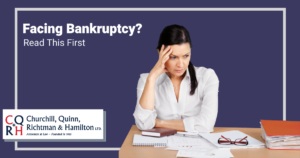Bankruptcy Basics: 3 Things You Need to Know Before Filing
 If times have been especially hard financially, and you are wondering how to find relief, know that you are not alone. Increasingly, many people are struggling with this exact problem. More and more employees have been laid off, or have had their income decreased, and are dealing with unpaid bills. In some cases, creditors are trying to offer solutions, but it may not be enough. If you believe a bankruptcy is the way out, read on for important information you’ll need to get started.
If times have been especially hard financially, and you are wondering how to find relief, know that you are not alone. Increasingly, many people are struggling with this exact problem. More and more employees have been laid off, or have had their income decreased, and are dealing with unpaid bills. In some cases, creditors are trying to offer solutions, but it may not be enough. If you believe a bankruptcy is the way out, read on for important information you’ll need to get started.
There are Different Types of Bankruptcy
One size does not fit all when it comes to a bankruptcy. Indeed, different situations call for different approaches. The two types of bankruptcy to consider are:
- Chapter 7 – The quickest way to eliminate all, or most, of your debt is to file a Chapter 7 This type of bankruptcy can clear away your unsecured debt in a matter of months. However, you will likely lose possession of much of your personal property. Additionally, it can have a lasting negative impact on your credit report.
- Chapter 13 –A Chapter 13 bankruptcy is a structured repayment plan that allows you to pay off your debt over 3-5 years, based on your monthly income. If you have the means to make monthly payments, this might be a good choice. Perhaps most importantly is because with this plan, you can stop foreclosure proceedings and avoid losing your home. However, with this plan you are not actually getting rid of your debt all at once. You are just paying it off with a modified payment plan. This might not be the right choice if you need a more immediate solution.
When you speak to one of our attorneys, we will discuss your specific circumstances and help you determine which of these options, if any, is most beneficial for your family.
Only Certain Debt can be Included in a Bankruptcy
You might be wondering what type of debt you would be able to eliminate if you decide to file a bankruptcy. The rules do differ a bit for chapter 7 and 13. However, both should allow you to discharge debt from credit cards, medical bills, personal loans, utility bills, back rent, lawsuit judgments or most other unsecured debts. Secured debt, such as a mortgage or car loan, can also be discharged. However, this also means that you would give up possession of that property.
When we review your outstanding bills, we can determine exactly which of your debts could be included, based on your specific case.
Some Accounts Cannot be Included
While a bankruptcy can offer you a fresh start, there are some types of debt that generally cannot be discharged in either type of filing. Some common examples would include child support and alimony, student loans, many types of taxes, fines or penalties owed to the government or courts, or personal injury debts that resulted from a drunk driving accident. Debts that are not included on your bankruptcy petition are also typically not discharged, so it is important to have a qualified attorney help you complete everything correctly.
Filing for bankruptcy is a serious decision. Therefore, it is important to consider both the pros and cons. You may think it is a necessary action, but it may not actually be the right choice. Speaking to a knowledgeable attorney is the best first step to determining your options. If you do decide to file for bankruptcy, you will need strong legal guidance along the way to make sure all of the paperwork is completed and filed properly. Contact Churchill, Quinn, Richtman & Hamilton, Ltd at 847-223-1500 to schedule your appointment with one of our experienced lawyers to discuss your case.
